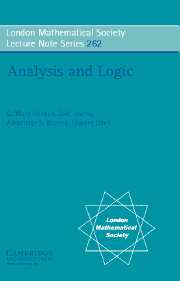Book contents
- Frontmatter
- Contents
- Preface
- Introduction
- Part One: Ultraproducts in Analysis
- 1 Introduction
- 2 Normed Space Structures
- 3 Signatures
- 4 Ultrapowers of Normed Space Structures
- 5 Positive Bounded Formulas
- Basic Model Theory I
- 7 Quantifier-Free Formulas
- 8 Ultraproducts of Normed Space Structures
- 9 Basic Model Theory II
- 10 Isomorphic Ultrapowers
- 11 Alternative Formulations of the Theory
- 12 Homogeneous Structures
- 13 More Model Theory
- 14 Types
- References
- Index of Notation
- Index
- Actions of Polish Groups and Classification Problems
- On Subspaces, Asymptotic Structure, and Distortion of Banach Spaces; Connections with Logic
1 - Introduction
Published online by Cambridge University Press: 05 May 2013
- Frontmatter
- Contents
- Preface
- Introduction
- Part One: Ultraproducts in Analysis
- 1 Introduction
- 2 Normed Space Structures
- 3 Signatures
- 4 Ultrapowers of Normed Space Structures
- 5 Positive Bounded Formulas
- Basic Model Theory I
- 7 Quantifier-Free Formulas
- 8 Ultraproducts of Normed Space Structures
- 9 Basic Model Theory II
- 10 Isomorphic Ultrapowers
- 11 Alternative Formulations of the Theory
- 12 Homogeneous Structures
- 13 More Model Theory
- 14 Types
- References
- Index of Notation
- Index
- Actions of Polish Groups and Classification Problems
- On Subspaces, Asymptotic Structure, and Distortion of Banach Spaces; Connections with Logic
Summary
The ideas and methods of model theory are being applied today in nearly all parts of mathematics. Here we concentrate on a framework for applications in functional analysis. Model theory has already provided several tools for the research analyst, of which the most important are: (a) the Banach space ultraproduct and nonstandard hull constructions in functional analysis; (b) spaces of (model-theoretic) types as used in the geometry of Banach spaces; and (c) Loeb measure spaces in stochastic analysis and its applications. In this paper we explain a systematic model theoretic framework within which these tools (especially (a) and (b)) are naturally situated. Our main intended audience consists of analysts who are familiar with the ultraproduct construction, and this perspective has strongly influenced our presentation of the material. We expect that many model theorists will also find something of interest in this subject. In particular, we indicate the initial steps of a program for introducing the key ideas and methods of model theory into functional analysis in a systematic and comprehensive way.
Applications of model theory in functional analysis have been pursued since the mid 1960s, beginning with the introduction of Banach space ultraproducts by Bretagnolle, Dacunha-Castelle, and Krivine [BDCK66] [Kri67] [DCK72] and nonstandard hulls by Luxemburg [Lux69b]. These two constructions Avere first used at about the same time and they are essentially the same; however, these initial steps led to largely independent lines of research that have still not been fully integrated.
- Type
- Chapter
- Information
- Analysis and Logic , pp. 3 - 9Publisher: Cambridge University PressPrint publication year: 2003



